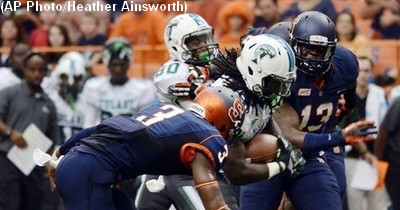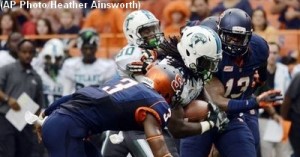
One third of the way through the 2013 campaign, the Syracuse football team is right where most expected and got there in the manner almost everyone expected. Following a pair of losses against Penn State and Northwestern, the Orange bounced back with a couple routs over Wagner and Tulane to reach the .500 mark. However, the Orange has made their journey back to even with some surprises and some things that may seem surprising, but actually are not.

After producing only in spurts during the first two contests, the Orange offense has operated expertly for almost all of the last two games. It piled up 106 points on Wagner and Tulane in doing something it had not done in recent years – blowing out significantly weaker competition. Last season’s 8-5 team featured a win over FCS opponent Stony Brook.
A 28-17 win.
Where SU trailed at half.
The year before, the Orange needed a touchdown pass pulled in by walk-on Mike Acchione midway through the fourth quarter to provide the winning margin over Rhode Island and a field goal from Ross Krautman on the game’s final play to edge Tulane, who would finish 2-11 on the year. The fact that Syracuse has rolled over the two weakest non-conference opponents this year suggests a different attitude on both sides of the ball.
» Related: Terrel Hunt continues torrid start as ACC play approaches
Obviously, the ACC portion of the schedule does not include foes of this lesser level, so it remains to be seen if the offensive explosion of the last two games will carry over to opponents that are evenly matched or better on paper. Jeff Sagarin’s computer ratings have Syracuse sitting at No. 62 in the nation. Of the eight conference foes slated to meet the Orange on the field, five hold higher rankings in that evaluation, including four of the top five in the ACC. SU’s new aggressive attitude will be tested, as the chance to prove it belongs in its new conference is here. At stake is a trip to its third bowl game in four seasons and climbing another rung toward re-establishing Syracuse as a football program of note.
In addition to the new attitude, the simple fact that SU has shown the ability to execute its offense lends an optimistic feel to its first foray through ACC wilderness, even though it appears to have a fairly steep uphill climb.
The primary trigger for the offensive rebirth of the Orange is its new quarterback, Terrel Hunt. After directing the team to seven consecutive scoring drives against Wagner, Hunt was elevated to the starting quarterback position on the depth chart. He responded by guiding the offense to seven touchdowns in his first 10 drives against Tulane.
Hunt must continue to rise to the occasion, however, as the ACC schedule does the Orange no favors. Seven of the eight teams remaining on the SU schedule have permitted 21 points per game or less. There is, of course, a lot of influence of lesser opponents on the statistical marks of these ACC teams, but the Orange has also faced some lower-level competition, yet permit 22 points per game.
Speaking of that defense, some familiar stories are back for this year’s version. The defense deployed by Scott Shafer and defensive coordinator Chuck Bullough is an ultra-aggressive one, blitzing from all angles and forcing opponents to handle a little bit of everything and do it quickly. It is the same style defense employed when Shafer was defensive coordinator on the Hill. It is also one that occasionally got burned for lots of yards and points in the previous four years.
» Related: Syracuse doesn’t need constant uniform makeover
Four times last season, the Orange gave up 30 points or more in a game, each time getting gashed for a minimum of 35 points. Five times, it permitted 400 yards or more of total offense. In fact, in Scott Shafer’s four-year tenure as defensive coordinator, 16 different SU opponents rolled up 400 yards or more in a game and 17 times, the Orange gave up at least 30 points in a contest. Simply stated, if the defense does not blitz successfully or fails to make open field tackles, it will get burned for big plays. The ACC is filled with dynamic playmakers who appear on the Syracuse schedule – Clemson’s quarterback Tajh Boyd and wide receiver Sammy Watkins, Florida State’s freshman sensation signal-caller Jameis Winston, Maryland’s wide receiver Stefon Diggs, Pitt’s receiving tandem of Devin Street and Tyler Boyd. They all can leave the Orange defense grasping for air and wondering what happened.
This is not to say that the defense is ineffective and the aggressive strategy should be discarded. The defensive unit has amassed 11 sacks on the year and five of them came in the two games against Big Ten foes. Tulane compiled 330 yards on offense, but Penn State, in comparison, collected 353. The SU defense held Penn State to 1.5 yards per rush attempt. The defense works, but it can be burned by skilled, speedy playmakers. It is a simple fact that has to be accepted as part of Scott Shafer’s affiliation with the program.
One major surprise for the Orange this year is how it has deployed its skill position players. At the outset of the season, the running back corps was widely viewed as the strength of the offense, especially Jerome Smith and Prince-Tyson Gulley, who combined to rack up more than 2,000 yards last season. Six different running backs have received carries already this season, slicing into the workload of last season’s two primary backs. Of 132 carries by running backs, Smith and Gulley have combined for 83, which is just less than 63 percent. Last year, the duo had 385 of the team’s 451 carries by running backs, good for 85.4 percent. While redshirt freshmen George Morris II and Devante McFarlane have looked like strong contributors in the future for the Orange, Smith looks like he put in a lot of work in the offseason improving his speed and balance and has earned a larger share of the workload. It remains to be seen if the offense will lean on the veteran even more.
» Related: Syracuse coming on strong for Thomas Holley
The receiving corps is going through a similar conversion. With last year’s starting wideouts Alec Lemon and Marcus Sales both gone, it was expected that Jarrod West would rise from his role as last year’s third wide receiver into this season’s leading man and tight end Beckett Wales would take on a much bigger role. With the exception of West’s performance against Wagner, this has not been the case. West caught five passes for 147 yards and a score against the Seahawks, but has six grabs for 64 yards in the other three games. Wales has been slowed by some minor injuries and only snared two passes.
Possibly as a direct result, the Orange has spread the ball around in the passing game, just as it has with their ground attack. A staggering 17 different players have already caught passes for SU in just four games. While a handful of those players have only caught a pass or two when the outcome of a game was already decided, only a dozen players caught passes last season for the Orange, including linebacker Lewellyn Coker snaring a touchdown toss in the “tank” package. The passing game plan at this point of the season seems to be not to focus on any one player, but to take what is given by the opposing defense.
Both of these themes of sharing the ball suggests there is a lack of “go-to guys” on the roster, which some may see as an indictment of the skill players. More likely, though, is that the uptempo offense employed by George McDonald employs a large number of skill position players to keep guys fresh and able to give maximum effort for clusters of plays, then sub out for a well-rested replacement.
The only thing guaranteed the rest of the way is more surprises for the Orange. Then again, what else should be expected from its new world.
For more Syracuse coverage, Like our Facebook page and follow us @TheJuiceOnline.

